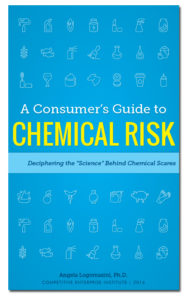 Will these chemicals make me fat? That sounds like a weird question, but some consumers may actually have such worries, thanks to a constant barrage of news headlines suggesting that synthetic chemicals—an even some naturally occurring ones—are responsible for nearly every public health problem imaginable.
Will these chemicals make me fat? That sounds like a weird question, but some consumers may actually have such worries, thanks to a constant barrage of news headlines suggesting that synthetic chemicals—an even some naturally occurring ones—are responsible for nearly every public health problem imaginable.
This website and CEI‘s A Consumers Guide to Chemical Risk: Deciphering the “Science” Behind Chemical Scares booklet are designed reduce both the confusion and fear about chemicals. It provides consumers with some insights on the science and the politics behind the headlines. When it comes to studies attempting to link chemicals and health ailments, the absolute risks are largely theoretical and generally too low to measure. In fact, many of the alarmist new stories report on studies where the findings are very weak and often inappropriate for drawing any conclusions
The science terms provided within the sidebar of this webpage offer an easy-to-understand, quick-reference guide to help consumers better recognize the difference between sound science and junk science. When confronted with a new claim, consumers can also evaluate the underlying science by asking the following questions:
- Is the association strong and statistically significant? Most of the studies in the news are merely statistical analyses that assess whether two factors occur at the same time. They don’t prove cause-and-effect relationships, which can only be inferred when the association is very strong. Accordingly, if researchers report a “weak association” or “suggestive” one, consumers should be suspicious of the claims.
- Is the sample any good? Ideally, a randomly selected, large sample of a population provides the best chance of good data, but locating and developing such samples is difficult and expensive. Accordingly, researchers often work with less-than-ideal samples and existing databases that offer imperfect data, or both. Accordingly, a study with 1,000 subjects is more reliable than one with 100 subjects.
- Are there serious confounding factors? The the possibility that a factor other than the two variables in question is responsible for the result is always present. While scientists attempt to apply “controls” in studies in an effort to negate the impact of such confounding factors, it does not always work. Consumers should be suspicious when there are other factors that more likely contributed to the result.
- What is the potential for recall bias among study participants? Some studies require interviewing subjects about their personal behavior, sometimes expecting them to recall chemical exposures dating back decades. The subject’s failure to recall the facts accurately can so undermine the validity of the data that the final study results are completely off the mark. Be wary of studies that rely on this type of subjective data collection.
- Does the language used by researchers suggest they are stretching the truth? Good researchers will strive to keep their biases in check, while still working toward finding something interesting. Yet others add “spin” to weak and meaningless “findings” to garner publication and media interest—and more funding. For example, researchers trying to prove that trace chemicals can make us fat have captured headlines by labeling these chemicals as “obesogens.” Their science may be weak and inconclusive, but their marketing it this way garners lots of media coverage.
- Is the study relevant to humans? Tests on rodents involve administering massive amounts of chemicals to animals bred to be highly susceptible to cancer, and many form tumors as a result. Despite what headlines may suggest, such tests are not particularly relevant to risks associated with human exposures to trace levels of chemicals.
- Is the exposure significant enough to matter? Many substances that are helpful or benign at low levels can sicken or kill at high levels. Accordingly, if the study involved high exposures, consumers should question whether it’s relevant to trace exposures through consumer products.
- Is the study peer reviewed and published? Peer review is designed for an industry to self-regulate to reduce fraud and poor quality research. While it alone isn’t sufficient to assure a study is completely sound, consumers should be very skeptical of claims from studies that have not undergone any peer review.
- Can other researchers reproduce the study results? Science is a long process of discovery that brings us closer to an answer as an issue is examined time and again. Part of that process involves repeating specific studies to see whether different scientists or teams of scientists can reproduce results of their peers’ or even their own research. If data is unavailable or other researchers have not been able to reproduce the result, the study is less compelling and may be discredited.
In addition, consumers should be alerted to sensationalist hype by simply playing attention to certain terms used by those in the alarmist trade. You can follow the links in the sidebar on this page to learn more about many of the key alarmist terms and phrases.
Browse the terms on the sidebar of this webpage for more details and/or download a copy of A Consumer’s Guide to Chemical Risk: Deciphering the “Science” Behind Chemical Scares.


[…] Competitive Enterprise Institute. This article in drawn in part from the author’s recent paper: A Consumer’s Guide to Chemical Risk: Deciphering the “Science” Behind Chemical Scares […]